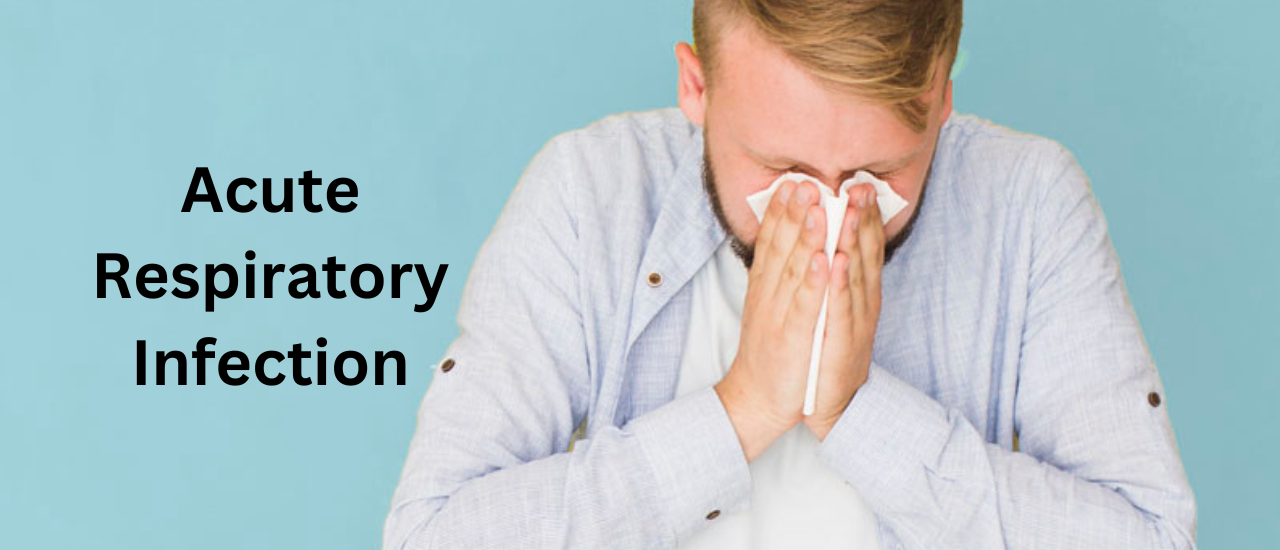


An infection known as an acute respiratory infections can make it difficult to breathe properly. You may just experience symptoms in your lower respiratory system, which begins at your voice box and finishes in your lungs, or simply your upper respiratory system, which starts at your sinuses and ends at your voice box. Children, older persons, and those with immune system diseases may experience major issues as a result. Children are more vulnerable because they interact with other kids who can be viral carriers. The majority of upper respiratory illnesses are easily disseminated and infectious. Inhaling respiratory droplets from coughing and sneezing might help spread the virus.
The term “upper respiratory tract” describes the uppermost part of the respiratory tract, which is primarily responsible for air conduction. It encompasses the throat, mouth, sinuses, and nose. The air first enters the nose while breathing through the nostrils. The nasal hair removes dust and you’ll experience throat and sinus infections.
The term “lower respiratory tract” refers to the respiratory system’s lowermost portion, which is mostly used for gas exchange. It consists of organs such the airway, lung, air sacs, and alveoli. The lungs and airways are both impacted by a lower respiratory illness. Lower respiratory infections typically linger longer and are more severe.
When a virus (or bacteria) enters your respiratory system, you develop an upper respiratory infection. For instance, you might shake hands with a sick individual or touch a contaminated surface. Next, you touch your eyes, nose, or mouth. Your body becomes infected by the bacteria on your hands. Acute respiratory infections can have a variety of causes. Upper and lower respiratory infection causes include:
Upper and lower respiratory infections have varied symptoms. However, some typical signs might be:
Anyone can get one of these infections because they are widespread. However, some demographics are more susceptible to contracting illnesses. Because they frequently interact with other kids who might be carrying a virus, children are at a high risk. Additionally, kids might wash their hands less regularly than adults do. They also have a higher propensity to stick their fingers in their mouths, noses, and eyes, which makes it easier for germs to spread. The chance of developing an upper respiratory infection is particularly higher in people who have heart or lung issues. Immune deficiencies can lead to more serious infections.
Respiratory failure and acute respiratory distress syndrome are the same. A person may make no effort to breathe or stop breathing entirely when respiratory insufficiency advances. Contrarily, those who are experiencing respiratory discomfort continue to make a lot of effort to breathe.
Indeed, upper respiratory illnesses spread easily. Through hand-to-hand contact or breathing droplets, they can spread from one person to another. Sneezing or coughing without protecting their mouth and nose can spread an upper respiratory infection to others.
The common cold is a very minor upper respiratory infection that is frequently brought on by a rhinovirus and typically gets better on its own. However, the virus that causes COVID-19, severe acute respiratory syndrome coronavirus 2, is potentially considerably more dangerous.
A chronic illness that damages the lungs’ airways is asthma. The arteries that let air into and out of your lungs are called airways. The airways may occasionally swell and restrict if you have asthma. As a result, it is more difficult for air to leave your airways when you exhale.
Infections of the respiratory system are important to understand whether you have asthma or live with someone who does. They have an impact on the airways, sinuses, throat, and nose. They contribute significantly to asthma symptoms and attacks. Additionally, some infections might trigger more severe illnesses like pneumonia. Protecting oneself from respiratory infections is important for those with asthma as well as those who are close to them. Respiratory illnesses that are typical include:
The influenza virus is what causes the flu, a respiratory ailment. The nose, throat, and even the lungs are affected. Every year, it extends from October until May. Millions of Americans suffer from the flu, a deadly sickness, each year. It results in thousands of deaths and sends hundreds of thousands of people to the hospital.
The SARS-CoV-2 virus, also known as the novel coronavirus, is the cause of COVID-19, a disease. In December 2019, it began to spread internationally. It is contagious and can lead to respiratory infections. Since the COVID-19 outbreak, more over 400,000 Americans have perished as a result of it. Some COVID-19 carriers may not exhibit any symptoms. However, other people, particularly the elderly and those with underlying medical issues, can get quite ill.
Pneumococcal disease is an uncommon condition. However, it can also result in less uncommon ailments such ear infections, pneumonia, meningitis, and sepsis. Although anybody can contract it, asthmatics are particularly vulnerable to problems. Disease from pneumococcal bacteria. Antibiotics are frequently effective in treating bacterial illnesses.
The typical cold is light and doesn’t lead to any major problems. But asthma symptoms can still be brought on by it. Even with asthma, care must be taken to avoid getting the flu. Since viruses are the cause of colds, antibiotics will not be of any assistance. Only bacteria are combated by antibiotics; viruses are not.
You can lessen your risk of contracting and spreading respiratory illnesses by taking the proper precautions.
How Mosquitos Zika Virus Affect During Pregnancy?
Cardiovascular Disease & How To Prevent CD In Child
Basic Detail About Chronic Kidney Disease Symptoms & Types